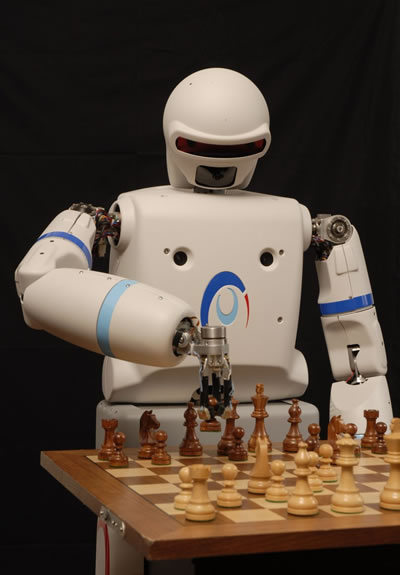Science Fiction
Dictionary
A B C D E F G H I J K L M N O P Q R S T U V W X Y Z
REEM-A Chess-Playing Robot

REEM-A is designed to play well with humans; it can play chess, hold objects, stroll around with people and answer questions and follow commands. REEM-A can also do face recognition.

(REEM-A ready to win at chess)
REEM-A is a prototype built by PAL Technology Robotics. The friendly robot is about four feet ten inches tall and weighs about ninety pounds. It can carry five pounds in each arm; both arms are equipped with gripper claws (which are also used when REEM-A plays chess.
(REEM-A plays chess to win)
REEM-A is in the tradition of science fictional robots that are easily able to walk with and converse with human beings. And play chess with them.
Moxon sat facing me at the farther side of a small table upon which a single candle made all the light that was in the room. Opposite him, his back toward me, sat another person. On the table between the two was a chessboard; the men were playing...The response of his antagonist, while equally prompt in the inception, was made with a slow, uniform, mechanical and, I thought, somewhat theatrical movement of the arm, that was a sore trial to my patience. There was something unearthly about it all, and I caught myself shuddering...
Then I remembered that Moxon had once spoken to me of having invented such a piece of mechanism, though I did not understand that it had actually been constructed.
(Read more about Ambrose Bierce's 1910 automaton chessplayer)
See more pictures and videos of REEM-A standing and walking with people; via PAL Technology Robotics.
Scroll down for more stories in the same category. (Story submitted 9/26/2007)
Follow this kind of news @Technovelgy.| Email | RSS | Blog It | Stumble | del.icio.us | Digg | Reddit |
Would
you like to contribute a story tip?
It's easy:
Get the URL of the story, and the related sf author, and add
it here.
Comment/Join discussion ( 1 )
Related News Stories - (" Robotics ")
Proof Of Robothood - Not A Person
'Who are you people? - Show 'em.' - James Cameron (1984).
Dancing Robots Taught Dance Moves
'A clockwork figure would be the thing for you...' Jerome K. Jerome, 1893.
Factory Humanoid Robots Built By Humanoid Robots
'...haven't you a section of the factory where only robot labor is employed?' - Isaac Asimov (1940).
Mornine Sales Robot
'Robot-salesmen were everywhere, gesturing...' - Philip K Dick, 1954.
Technovelgy (that's tech-novel-gee!) is devoted to the creative science inventions and ideas of sf authors. Look for the Invention Category that interests you, the Glossary, the Invention Timeline, or see what's New.
Science Fiction
Timeline
1600-1899
1900-1939
1940's 1950's
1960's 1970's
1980's 1990's
2000's 2010's
Current News
Natural Gait With Prosthetic Connected To Nervous System
'The leg was to function, in a way, as a servo-mechanism operated by Larry’s brain...'
Woman Marries Computer, Vonnegut's Dream Comes True
'Men are made of protoplasm... Lasts forever.'
Spidery 'Walk Me' Toyota Autonomous Wheel Chair Like Star Wars
Walk along with the emperor.
Dancing Robots Taught Dance Moves
'A clockwork figure would be the thing for you...'
Proof Of Robothood - Not A Person
'Who are you people? - Show 'em.'
Indonesian Clans Battle
'The observation vehicle was of that peculiar variety used in conveying a large number of people across rough terrain.'
The 'Last Mile' In China Crowded With Delivery Robots
Yes, it's a delivery robot. On wheels.
Tornyol Microdrone Kills Mosquitoes
'The real border was defended by... a swarm of quasi-independent aerostats.'
PLATO Spacecraft, Hunter Of Habitable Planets, Now Ready
'I ... set my automatic astronomical instruments to searching for a habitable planet.'
Factory Humanoid Robots Built By Humanoid Robots
'...haven't you a section of the factory where only robot labor is employed?'
iPhone Air Fulfils Jobs' Promise From 2007 - A Giant Screen!
'... oblongs were all over the floor and surfaces.'
ChatGPT Now Participates in Group Chats
'...the city was their laboratory in human psychology.'
iPhone Pocket All Sold Out!
'A long, strong, slender net...'
Did The Yautja Have These First?
What a marvel of ingenuity the little device was!
Jetson ONE Air Races Begin, Can Air Polo Be Far Behind?
'If you're one of those rarities who haven't attended a rocket-polo "carnage", let me tell you it's a colorful affair.'
Will Space Stations Have Large Interior Spaces Again?
'They filed clumsily into the battleroom, like children in a swimming pool for the first time, clinging to the handholds along the side.'
